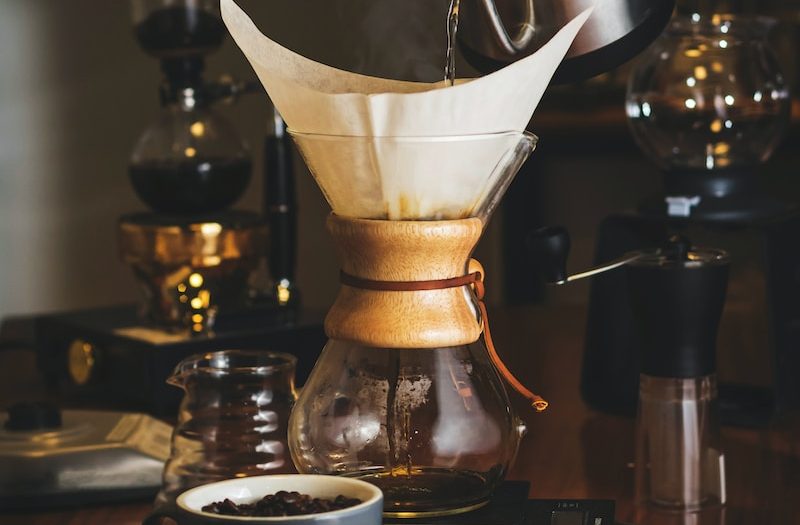Hello there, coffee connoisseurs and curious caffeine enthusiasts! I’m Sarah Brewer, and I’ve been on a caffeinated journey through time, exploring the fascinating evolution of coffee brewing methods. If there’s one brewing device that has truly tickled my taste buds and piqued my interest, it’s the Siphon Brewer. Let’s dive into the captivating history of this quirky contraption, and how it has managed to stay relevant in the ever-evolving world of coffee craft.
A Glimpse into the Past
Our story begins in the early 19th century, a time when the Industrial Revolution was in full swing, and inventors were tinkering away with contraptions of all kinds. In 1830, a French housewife named Marie Fanny Amelne Massot received a patent for an early version of the siphon brewer, which she simply called “the coffee machine.” However, it was a Frenchman named Loeff of Berlin who patented the first true siphon coffee maker in 1841. That’s right, the French and the Germans were already duking it out in the coffee world back then!
The siphon brewer, also known as a vacuum coffee maker or a syphon, uses a combination of vapor pressure and gravity to brew a cup of java that’s smooth, aromatic, and uniquely captivating. The brewer consists of two chambers – a lower one for water and a top one for coffee grounds. A cloth or paper filter sits between the two, allowing the coffee to infuse without any gritty bits sneaking into your cup.
The Art of Brewing with Siphon
If you’ve ever watched a siphon brewer in action, you know that it’s a mesmerizing experience. It looks like a mini science experiment right there in your kitchen. The process begins by heating the lower chamber, causing the water to rise into the upper chamber. Once the water is fully evaporated, it joins the ground coffee in the upper chamber. When you remove the heat source, the lower chamber cools down, creating a vacuum effect that draws the brewed coffee back down, leaving the grounds behind in the upper chamber.
It’s like the coffee is putting on a show for you, a performance of chemistry and precision. Now, this brew method may seem a tad complicated at first, but trust me, once you’ve tried it, you’ll be hooked. There’s something incredibly satisfying about watching the coffee travel up and down in a siphon brewer. It’s a beautiful balance of science and artistry that adds to the overall coffee experience.
A Golden Age in the Early 20th Century
Siphon brewers quickly gained popularity across Europe and North America in the late 19th and early 20th centuries. In fact, they were a staple in many households, and elegant siphon coffee sets graced the tables of the elite. This era marked the golden age of siphon brewing, with manufacturers like Hario and Cona producing these beautiful pieces of coffee machinery that doubled as works of art.
With its unique brewing process, the siphon brewer delivered a cup of coffee that was distinct from other methods like drip or percolator brewing. The coffee produced was exceptionally clean, bright, and rich, and the method became synonymous with coffee refinement.
A Dip in Popularity
However, as the mid-20th century rolled around, the siphon brewer began to lose its shine. The convenience of automatic drip coffee makers and the rise of instant coffee put the siphon on the back burner for many households. But, as we know, true classics never go out of style.

The Resurgence of Siphon Brewing
Fast forward to the late 20th and early 21st century, and we saw a resurgence in the popularity of siphon brewing. Specialty coffee enthusiasts and third-wave coffee shops started dusting off the old siphons and experimenting with this method once again.
Why the comeback, you ask? Well, it’s partly due to the renewed interest in the art of coffee making. As people started to appreciate the complexities of coffee flavors and the importance of brewing methods, the siphon brewer’s unique qualities began to shine once more.
Siphon Brewing in the Modern Era
The modern siphon brewer has seen some upgrades and tweaks. You’ll find everything from glass and stainless steel models to electric siphons that eliminate the need for an open flame. And don’t forget about the variety of filters available, including cloth, metal, and paper, each offering a slightly different brewing experience.
One of the reasons for the siphon’s resurgence is the meticulous control it provides over the brewing process. With a siphon brewer, you can adjust parameters like temperature, brewing time, and coffee-to-water ratio to achieve a cup that perfectly suits your taste.
The Siphon’s Place in Coffee Culture
The siphon brewer’s resurgence is not just about functionality but also its place in coffee culture. When you order a siphon-brewed coffee at a specialty coffee shop, it’s an experience. The method becomes part of the show, a live performance where you can watch your coffee being brewed with precision and care.
While many other brewing methods are more automated and efficient, the siphon brewer connects us to the origins of coffee-making. It’s a slow and deliberate process, reminiscent of the days when coffee was a carefully prepared delicacy rather than a rushed morning ritual. In a world that’s always in a hurry, the siphon brewer encourages us to take a step back and savor the process as much as the final cup.
Siphon Brewing at Home
Now, you might be wondering if the siphon brewer is a practical choice for your daily coffee routine. The answer is a resounding yes! While it may require a bit more patience and attention than a standard drip coffee maker, the results are worth it.
If you’re considering bringing a siphon brewer into your home, here are a few tips to get you started:
Choose the Right Brewer:
There are many models available, so select one that suits your preferences and budget. Some are simple and manual, while others come with built-in heating elements for added convenience.
Fresh Coffee:
As with any brewing method, start with freshly roasted and ground coffee beans. The siphon brewer will highlight the unique flavors of high-quality beans.

Experiment:
Don’t be afraid to experiment with variables like grind size, brewing time, and water temperature to find the perfect balance for your palate.
Practice Patience:
Siphon brewing is a bit slower than other methods, so use this time to relax and enjoy the process.
Savor the Moment:
When your coffee is ready, take a moment to savor the unique flavors and aroma that the siphon method has extracted.
Conclusion
In the world of coffee, it’s essential to pay homage to the methods that have paved the way for the innovative coffee culture we enjoy today. The s
Olivia Sinclair is the creative mind behind the “Coffee Machines and Other Things Affiliate” blog. With a passion for all things coffee-related and a keen interest in the world of affiliate marketing, Olivia has managed to blend her two passions into a successful online venture. Born and raised in Seattle, the heart of coffee culture, Olivia’s love for coffee started at an early age. She spent her formative years exploring local coffee shops, learning the art of brewing, and appreciating the nuances of coffee beans from around the world.
After completing her Bachelor’s degree in Marketing and Communications, Olivia embarked on a career that led her into the world of affiliate marketing. She soon realized that her true calling lay in combining her marketing expertise with her love for coffee. This realization gave birth to the “Coffee Machines and Other Things Affiliate” blog, where Olivia shares her in-depth knowledge of coffee machines, brewing methods, and other related products. Her insightful reviews and well-researched recommendations have made her a trusted source for coffee enthusiasts seeking guidance on their purchases.
When she’s not busy exploring the latest coffee trends and testing new products, you can find Olivia hiking in the beautiful Pacific Northwest or honing her latte art skills. She believes in the power of a great cup of coffee to brighten anyone’s day and is dedicated to helping her readers find the perfect coffee-related products to elevate their coffee experience.
